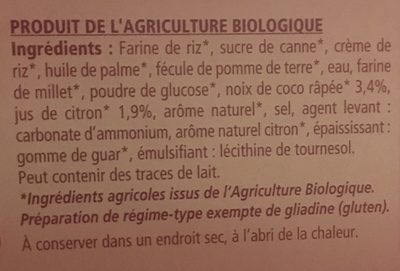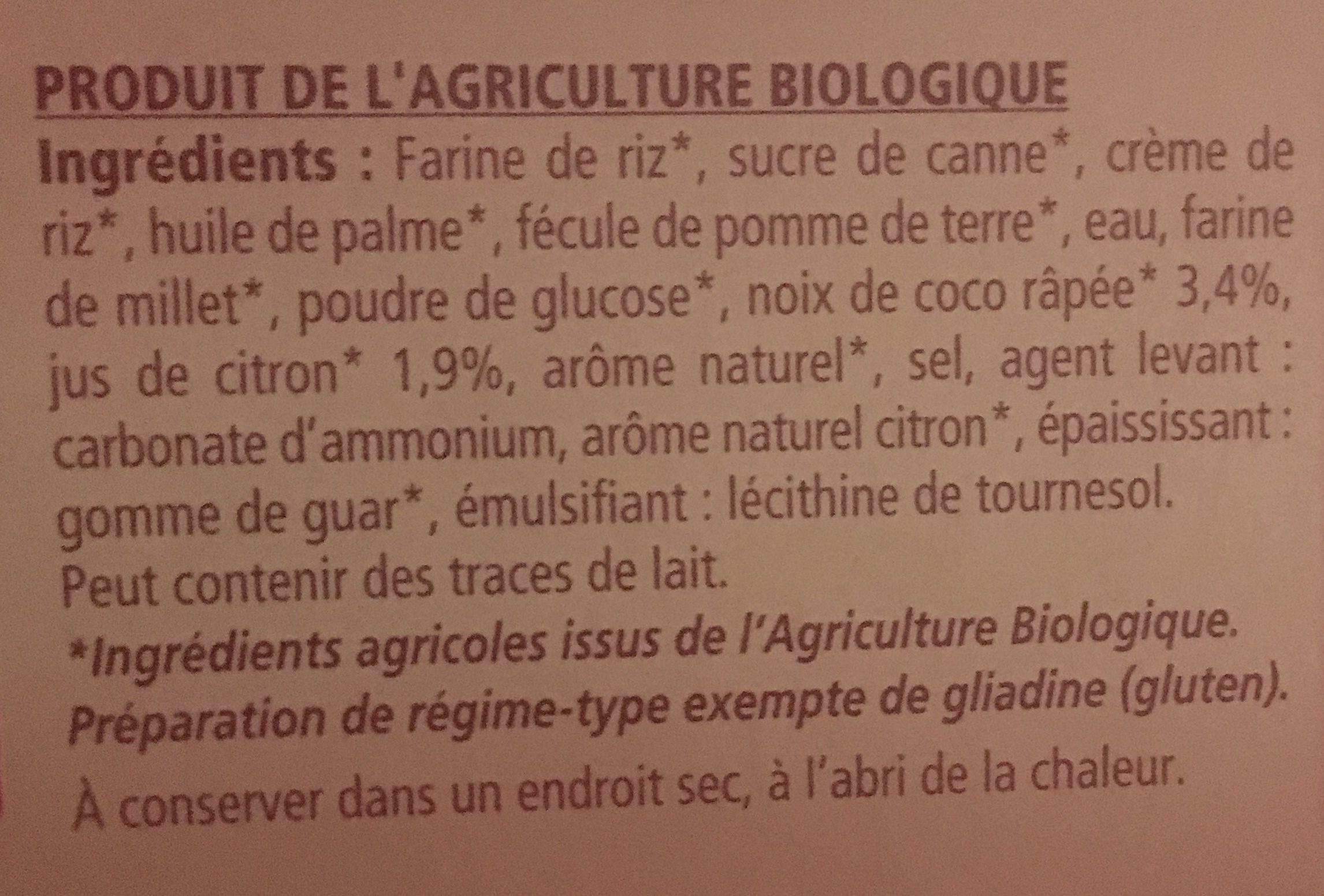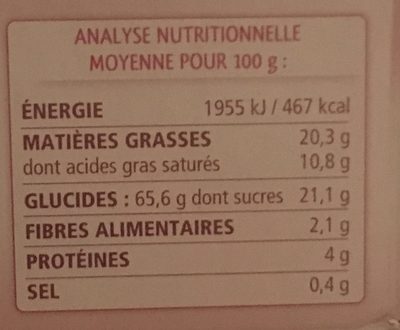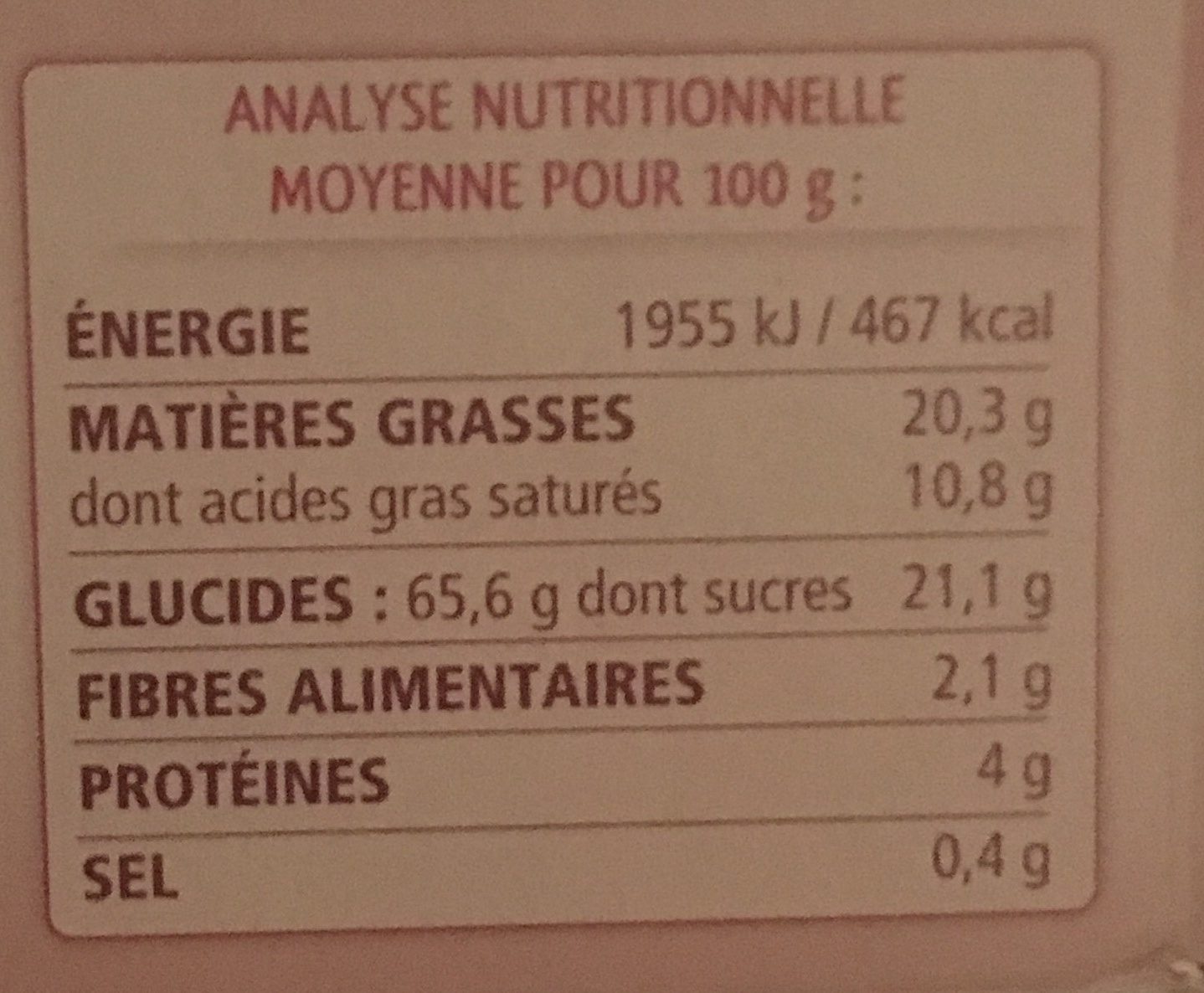Help us make food transparency the norm!
As a non-profit organization, we depend on your donations to continue informing consumers around the world about what they eat.
The food revolution starts with you!
Sablés à la noix de coco - La Vie Claire - 125 g
Sablés à la noix de coco - La Vie Claire - 125 g
This product page is not complete. You can help to complete it by editing it and adding more data from the photos we have, or by taking more photos using the app for Android or iPhone/iPad. Thank you!
×
Barcode: 3266191007793 (EAN / EAN-13)
Quantity: 125 g
Brands: La Vie Claire
Categories: Snacks, Sweet snacks, Biscuits and cakes, Biscuits, Shortbread cookies, Shortbread cookie with coconut, Sablés à la noix de coco
Labels, certifications, awards:
No gluten, Organic, EU Organic, Non-EU Agriculture, EU Agriculture, EU/non-EU Agriculture, FR-BIO-01, AB Agriculture Biologique

Stores: La Vie Claire
Countries where sold: France
Matching with your preferences
Health
Ingredients
-
20 ingredients
French: Farine de riz* , sucre de canne*, crème de riz* , huile de palme* , fécule de pomme de terre* , eau, farine de millet* , poudre de glucose* , noix de coco râpée* 3,4%, jus de citron* 1,9%, arôme naturel* , sel, agent levant : carbonate d'ammonium, arôme naturel citron* , épaississant : gomme de guar*, émulsifiant : lécithine de tournesol, Peut contenir des traces de lait. *Ingrédients agricoles issus de l'Agriculture Biologique, Préparation de régime-type exempte de gliadine (gluten).Allergens: GlutenTraces: Gluten, Milk
Food processing
-
Ultra processed foods
Elements that indicate the product is in the 4 - Ultra processed food and drink products group:
- Additive: E322 - Lecithins
- Additive: E412 - Guar gum
- Ingredient: Emulsifier
- Ingredient: Flavouring
- Ingredient: Glucose
- Ingredient: Thickener
Food products are classified into 4 groups according to their degree of processing:
- Unprocessed or minimally processed foods
- Processed culinary ingredients
- Processed foods
- Ultra processed foods
The determination of the group is based on the category of the product and on the ingredients it contains.
Additives
-
E322 - Lecithins
Lecithins are natural compounds commonly used in the food industry as emulsifiers and stabilizers.
Extracted from sources like soybeans and eggs, lecithins consist of phospholipids that enhance the mixing of oil and water, ensuring smooth textures in various products like chocolates, dressings, and baked goods.
They do not present any known health risks.
-
E322i - Lecithin
Lecithins are natural compounds commonly used in the food industry as emulsifiers and stabilizers.
Extracted from sources like soybeans and eggs, lecithins consist of phospholipids that enhance the mixing of oil and water, ensuring smooth textures in various products like chocolates, dressings, and baked goods.
They do not present any known health risks.
-
E412 - Guar gum
Guar gum (E412) is a natural food additive derived from guar beans.
This white, odorless powder is valued for its remarkable thickening and stabilizing properties, making it a common ingredient in various food products, including sauces, dressings, and ice creams.
When used in moderation, guar gum is considered safe for consumption, with no known adverse health effects.
-
E503 - Ammonium carbonates
Ammonium carbonate: Ammonium carbonate is a salt with the chemical formula -NH4-2CO3. Since it readily degrades to gaseous ammonia and carbon dioxide upon heating, it is used as a leavening agent and also as smelling salt. It is also known as baker's ammonia and was a predecessor to the more modern leavening agents baking soda and baking powder. It is a component of what was formerly known as sal volatile and salt of hartshorn.Source: Wikipedia
-
E503i - Ammonium carbonate
Ammonium carbonate: Ammonium carbonate is a salt with the chemical formula -NH4-2CO3. Since it readily degrades to gaseous ammonia and carbon dioxide upon heating, it is used as a leavening agent and also as smelling salt. It is also known as baker's ammonia and was a predecessor to the more modern leavening agents baking soda and baking powder. It is a component of what was formerly known as sal volatile and salt of hartshorn.Source: Wikipedia
Ingredients analysis
-
Palm oil
Ingredients that contain palm oil: Palm oil
-
Vegan status unknown
Unrecognized ingredients: fr:preparation-de-regime-type-exempte-de-gliadineSome ingredients could not be recognized.
We need your help!
You can help us recognize more ingredients and better analyze the list of ingredients for this product and others:
- Edit this product page to correct spelling mistakes in the ingredients list, and/or to remove ingredients in other languages and sentences that are not related to the ingredients.
- Add new entries, synonyms or translations to our multilingual lists of ingredients, ingredient processing methods, and labels.
If you would like to help, join the #ingredients channel on our Slack discussion space and/or learn about ingredients analysis on our wiki. Thank you!
-
Vegetarian status unknown
Unrecognized ingredients: fr:preparation-de-regime-type-exempte-de-gliadineSome ingredients could not be recognized.
We need your help!
You can help us recognize more ingredients and better analyze the list of ingredients for this product and others:
- Edit this product page to correct spelling mistakes in the ingredients list, and/or to remove ingredients in other languages and sentences that are not related to the ingredients.
- Add new entries, synonyms or translations to our multilingual lists of ingredients, ingredient processing methods, and labels.
If you would like to help, join the #ingredients channel on our Slack discussion space and/or learn about ingredients analysis on our wiki. Thank you!
-
Details of the analysis of the ingredients
We need your help!
Some ingredients could not be recognized.
We need your help!
You can help us recognize more ingredients and better analyze the list of ingredients for this product and others:
- Edit this product page to correct spelling mistakes in the ingredients list, and/or to remove ingredients in other languages and sentences that are not related to the ingredients.
- Add new entries, synonyms or translations to our multilingual lists of ingredients, ingredient processing methods, and labels.
If you would like to help, join the #ingredients channel on our Slack discussion space and/or learn about ingredients analysis on our wiki. Thank you!
fr: Farine de riz, sucre de canne, crème de riz, huile de palme, fécule de pomme de terre, eau, farine de millet, poudre de glucose, noix de coco 3.4%, jus de citron 1.9%, arôme naturel, sel, agent levant (carbonate d'ammonium), arôme naturel citron, épaississant (gomme de guar), émulsifiant (lécithine de tournesol), Préparation de régime-type exempte de gliadine- Farine de riz -> en:rice-flour - labels: en:organic - vegan: yes - vegetarian: yes - ciqual_food_code: 9520 - percent_min: 5.88235294117647 - percent_max: 70.9
- sucre de canne -> en:cane-sugar - labels: en:organic - vegan: yes - vegetarian: yes - ciqual_proxy_food_code: 31016 - percent_min: 3.4 - percent_max: 16.1
- crème de riz -> fr:creme-de-riz - labels: en:organic - vegan: yes - vegetarian: yes - ciqual_proxy_food_code: 9100 - percent_min: 3.4 - percent_max: 16.1
- huile de palme -> en:palm-oil - labels: en:organic - vegan: yes - vegetarian: yes - from_palm_oil: yes - ciqual_food_code: 16129 - percent_min: 3.4 - percent_max: 16.1
- fécule de pomme de terre -> en:potato-starch - labels: en:organic - vegan: yes - vegetarian: yes - ciqual_proxy_food_code: 9510 - percent_min: 3.4 - percent_max: 16.1
- eau -> en:water - vegan: yes - vegetarian: yes - ciqual_food_code: 18066 - percent_min: 3.4 - percent_max: 14.65
- farine de millet -> en:millet-flour - labels: en:organic - vegan: yes - vegetarian: yes - ciqual_food_code: 9555 - percent_min: 3.4 - percent_max: 13.0428571428571
- poudre de glucose -> en:glucose-powder - labels: en:organic - vegan: yes - vegetarian: yes - ciqual_proxy_food_code: 31016 - percent_min: 3.4 - percent_max: 11.8375
- noix de coco -> en:coconut - labels: en:organic - vegan: yes - vegetarian: yes - ciqual_proxy_food_code: 15006 - percent_min: 3.4 - percent: 3.4 - percent_max: 3.4
- jus de citron -> en:lemon-juice - labels: en:organic - vegan: yes - vegetarian: yes - ciqual_food_code: 2028 - percent_min: 1.9 - percent: 1.9 - percent_max: 1.9
- arôme naturel -> en:natural-flavouring - labels: en:organic - vegan: maybe - vegetarian: maybe - percent_min: 0 - percent_max: 1.9
- sel -> en:salt - vegan: yes - vegetarian: yes - ciqual_food_code: 11058 - percent_min: 0 - percent_max: 0.4
- agent levant -> en:raising-agent - percent_min: 0 - percent_max: 0.4
- carbonate d'ammonium -> en:e503i - vegan: yes - vegetarian: yes - percent_min: 0 - percent_max: 0.4
- arôme naturel citron -> en:natural-lemon-flavouring - labels: en:organic - vegan: yes - vegetarian: yes - percent_min: 0 - percent_max: 0.4
- épaississant -> en:thickener - percent_min: 0 - percent_max: 0.4
- gomme de guar -> en:e412 - labels: en:organic - vegan: yes - vegetarian: yes - percent_min: 0 - percent_max: 0.4
- émulsifiant -> en:emulsifier - percent_min: 0 - percent_max: 0.4
- lécithine de tournesol -> en:sunflower-lecithin - vegan: yes - vegetarian: yes - percent_min: 0 - percent_max: 0.4
- Préparation de régime-type exempte de gliadine -> fr:preparation-de-regime-type-exempte-de-gliadine - percent_min: 0 - percent_max: 0.4
Nutrition
-
Poor nutritional quality
⚠ ️Warning: the amount of fruits, vegetables and nuts is not specified on the label, it was estimated from the list of ingredients: 5This product is not considered a beverage for the calculation of the Nutri-Score.
Positive points: 2
- Proteins: 2 / 5 (value: 4.7, rounded value: 4.7)
- Fiber: 2 / 5 (value: 2.1, rounded value: 2.1)
- Fruits, vegetables, nuts, and colza/walnut/olive oils: 0 / 5 (value: 5.3, rounded value: 5.3)
Negative points: 13
- Energy: 5 / 10 (value: 1766, rounded value: 1766)
- Sugars: 3 / 10 (value: 16.1, rounded value: 16.1)
- Saturated fat: 4 / 10 (value: 5, rounded value: 5)
- Sodium: 1 / 10 (value: 160, rounded value: 160)
The points for proteins are not counted because the negative points are greater or equal to 11.
Nutritional score: (13 - 2)
Nutri-Score:
-
Nutrient levels
-
Fat in moderate quantity (15.4%)
What you need to know- A high consumption of fat, especially saturated fats, can raise cholesterol, which increases the risk of heart diseases.
Recommendation: Limit the consumption of fat and saturated fat- Choose products with lower fat and saturated fat content.
-
Saturated fat in moderate quantity (5%)
What you need to know- A high consumption of fat, especially saturated fats, can raise cholesterol, which increases the risk of heart diseases.
Recommendation: Limit the consumption of fat and saturated fat- Choose products with lower fat and saturated fat content.
-
Sugars in high quantity (16.1%)
What you need to know- A high consumption of sugar can cause weight gain and tooth decay. It also augments the risk of type 2 diabetes and cardio-vascular diseases.
Recommendation: Limit the consumption of sugar and sugary drinks- Sugary drinks (such as sodas, fruit beverages, and fruit juices and nectars) should be limited as much as possible (no more than 1 glass a day).
- Choose products with lower sugar content and reduce the consumption of products with added sugars.
-
Salt in moderate quantity (0.4%)
What you need to know- A high consumption of salt (or sodium) can cause raised blood pressure, which can increase the risk of heart disease and stroke.
- Many people who have high blood pressure do not know it, as there are often no symptoms.
- Most people consume too much salt (on average 9 to 12 grams per day), around twice the recommended maximum level of intake.
Recommendation: Limit the consumption of salt and salted food- Reduce the quantity of salt used when cooking, and don't salt again at the table.
- Limit the consumption of salty snacks and choose products with lower salt content.
-
-
Nutrition facts
Nutrition facts As sold
for 100 g / 100 mlCompared to: Sables-a-la-noix-de-coco Energy 1,766 kj
(422 kcal)-16% Fat 15.4 g -41% Saturated fat 5 g -68% Carbohydrates 65.2 g +10% Sugars 16.1 g -29% Fiber 2.1 g -43% Proteins 4.7 g -25% Salt 0.4 g -24% Fruits‚ vegetables‚ nuts and rapeseed‚ walnut and olive oils (estimate from ingredients list analysis) 5.3 %
Environment
-
Eco-Score C - Moderate environmental impact
⚠ ️Select a country in order to include the full impact of transportation.The Eco-Score is an experimental score that summarizes the environmental impacts of food products.→ The Eco-Score was initially developped for France and it is being extended to other European countries. The Eco-Score formula is subject to change as it is regularly improved to make it more precise and better suited to each country.Life cycle analysis
-
Average impact of products of the same category: B (Score: 72/100)
Category: Shortbread cookie w coconut
Category: Shortbread cookie w coconut
- PEF environmental score: 0.33 (the lower the score, the lower the impact)
- including impact on climate change: 2.49 kg CO2 eq/kg of product
Stage Impact Agriculture
78.6 %Processing
12.0 %Packaging
3.4 %Transportation
4.5 %Distribution
1.5 %Consumption
0.0 %
Bonuses and maluses
-
Labels with high environmental benefits
Bonus: +15
-
AB Agriculture Biologique
Organic agriculture contributes to preserve biodiversity, climate, water quality and soil fertility.
Organic food is food produced by methods complying with the standards of organic farming and features practices that cycle resources, promote ecological balance, and conserve biodiversity.
-
EU Organic
Organic agriculture contributes to preserve biodiversity, climate, water quality and soil fertility.
Organic food is food produced by methods complying with the standards of organic farming and features practices that cycle resources, promote ecological balance, and conserve biodiversity.
-
-
Missing origins of ingredients information
Malus: -5
⚠ ️ The origins of the ingredients of this product are not indicated.
If they are indicated on the packaging, you can modify the product sheet and add them.
If you are the manufacturer of this product, you can send us the information with our free platform for producers.
-
Ingredients that threatens species
Malus: -10
Contains palm oil
Tropical forests in Asia, Africa and Latin America are destroyed to create and expand oil palm tree plantations. The deforestation contributes to climate change, and it endangers species such as the orangutan, the pigmy elephant and the Sumatran rhino.
-
Missing packaging information for this product
Malus: -15
⚠ ️ The information about the packaging of this product is not filled in.⚠ ️ For a more precise calculation of the Eco-Score, you can modify the product page and add them.
If you are the manufacturer of this product, you can send us the information with our free platform for producers.
Eco-Score for this product
-
Impact for this product: C (Score: 57/100)
Product: Sablés à la noix de coco - La Vie Claire - 125 g
Life cycle analysis score: 72
Sum of bonuses and maluses: -15
Final score: 57/100
-
Carbon footprint
-
Equal to driving 1.3 km in a petrol car
249 g CO² per 100g of product
The carbon emission figure comes from ADEME's Agribalyse database, for the category: Shortbread cookie w coconut (Source: ADEME Agribalyse Database)
Stage Impact Agriculture
79.7 %Processing
8.5 %Packaging
4.4 %Transportation
6.6 %Distribution
0.8 %Consumption
0.0 %
Packaging
-
Missing packaging information for this product
⚠ ️ The information about the packaging of this product is not filled in.Take a photo of the recycling information Take a photo of the recycling information
Transportation
-
Origins of ingredients
Missing origins of ingredients information
⚠ ️ The origins of the ingredients of this product are not indicated.
If they are indicated on the packaging, you can modify the product sheet and add them.
If you are the manufacturer of this product, you can send us the information with our free platform for producers.Add the origins of ingredients for this product Add the origins of ingredients for this product
Threatened species
-
Contains palm oil
Drives deforestation and threatens species such as the orangutan
Tropical forests in Asia, Africa and Latin America are destroyed to create and expand oil palm tree plantations. The deforestation contributes to climate change, and it endangers species such as the orangutan, the pigmy elephant and the Sumatran rhino.
Labels
-
AB Agriculture Biologique
Organic agriculture contributes to preserve biodiversity, climate, water quality and soil fertility.
Organic food is food produced by methods complying with the standards of organic farming and features practices that cycle resources, promote ecological balance, and conserve biodiversity.
-
EU Organic
Organic agriculture contributes to preserve biodiversity, climate, water quality and soil fertility.
Organic food is food produced by methods complying with the standards of organic farming and features practices that cycle resources, promote ecological balance, and conserve biodiversity.
Report a problem
-
Incomplete or incorrect information?
Category, labels, ingredients, allergens, nutritional information, photos etc.
If the information does not match the information on the packaging, please complete or correct it. Open Food Facts is a collaborative database, and every contribution is useful for all.
Data sources
Product added on by kiliweb
Last edit of product page on by moon-rabbit.
Product page also edited by openfoodfacts-contributors, roboto-app, tacinte, teolemon, yuka.WHY0WlM0QXo5OVVOd3RvSDNSM2UvZUJVeUsrcldIRytETzBCSWc9PQ.












